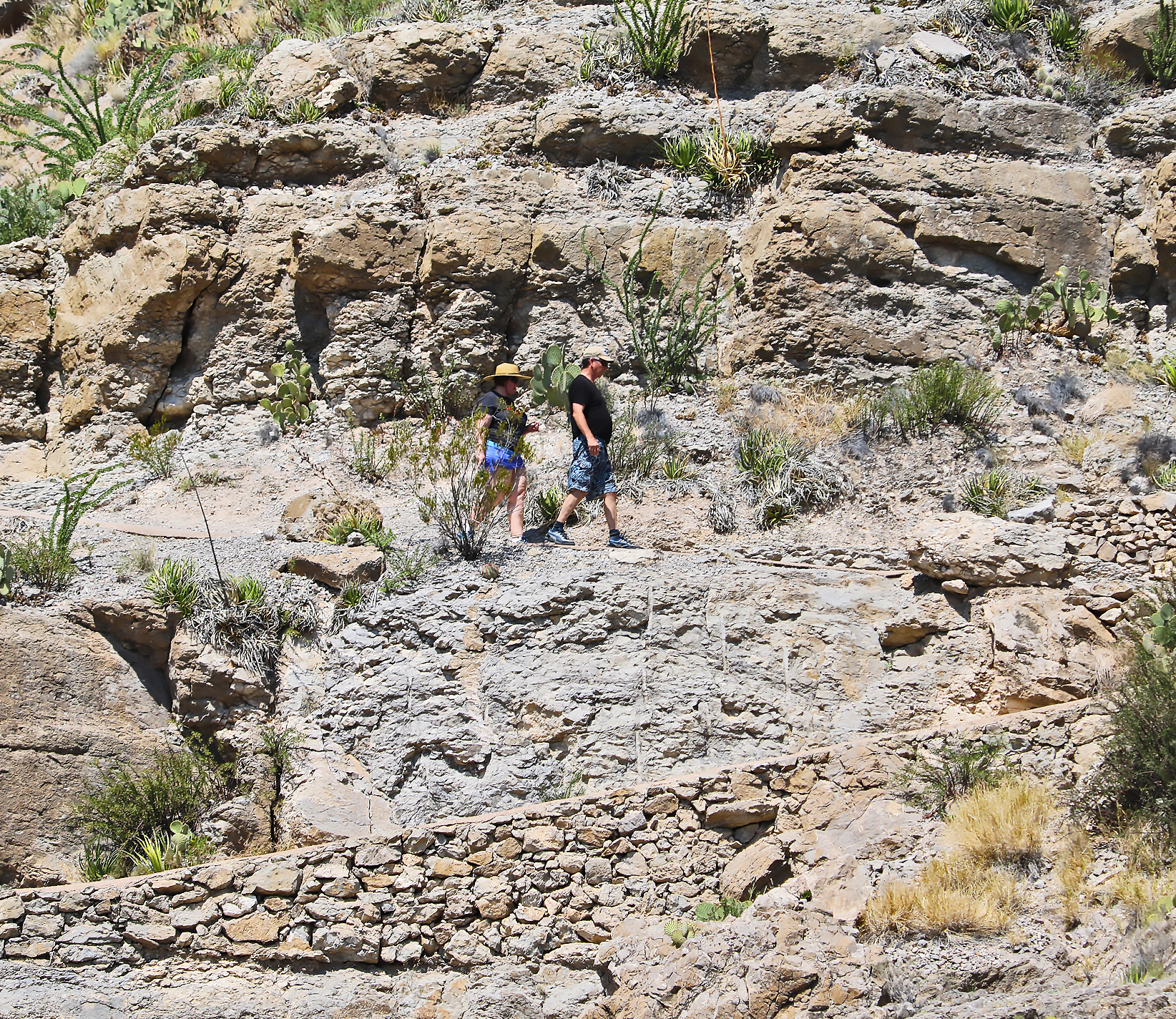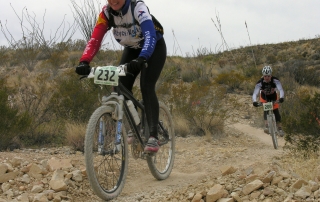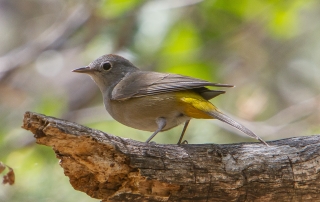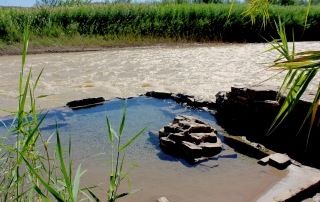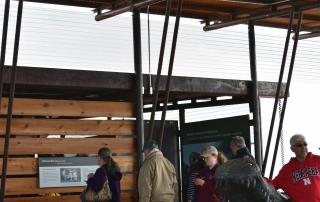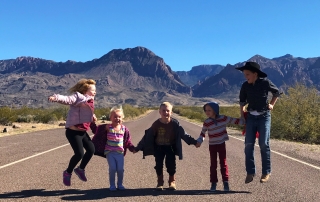Big Bend offers a variety of hiking opportunities, everything from short interpretive walks, to rugged, multi day excursions. Big Bend National Park alone features a system of over 150 miles of improved hiking trails. Hikers are allowed to travel off trail if they want to; there are two short but very scenic ADA accessible paved trails. Day hikes require no permit in Big Bend National Park.
Although many trails in the area are well marked and easily followed, hiring a guide can provide a more complete Big Bend experience. Not only do guides know the way to all the best places, they are also first aid trained and knowledgeable about the local geology, history, flora and fauna. Try one of the following services:
Big Bend Boating and Hiking Company, LLC , Terlingua, TX 79852 469-607-9869
Big Bend River Tours , FM 170 near the junction of FM 170 and TX 118. 800-545-4240, local 371-3033
Big Bend Expeditions offers guided 4×4 tours of the rugged country near their property, taking guests to remote sites of archeological and geological interest. 888-408-2945
Desert Sports offers guided hiking, guided rafting, guided canoeing, guided mountain biking, bike rentals, river gear rental, vehicle shuttle service, and bike repair. Located at 22937 FM 170 in Terlingua. 432-371-2727
Far Flung Outdoor Center, FM 170 near junction of FM 170 and TX 118. 432-371-2633
Get Lost Tours, From Vehicle to Hiking, from Sunrise to Sunset, and Specialty tours focusing on the Spectrum & Abused communities, GLT works with All. 432-371-3301 or 432-294-1580
Introduction
This booklet has been planned to provide all Park Visitors with the information necessary to enjoy Big Bend on foot to the fullest extent of their abilities and desires. Don’t let the title scare you. The “hikes” listed herein vary in length from 50 yards to 33 miles. However, most are less than five miles long and can be taken as relatively easy day hikes. Hopefully, the information contained here will encourage you to get out of your car and to experience Big Bend in all of its primitive, rugged beauty. There are few places left in the United States today where you can completely escape from man-made intrusions. Big Bend is such a place. Take advantage of its unspoiled nature. Listen to the quiet. Take a few deep gulps of pure, unpolluted air. Let a little of the Big Bend Mystique invade your consciousness. Be thankful that places like Big Bend still exist.
Published and copyright 1978 by Big Bend Natural History Association in cooperation with the NATIONAL PARK SERVICE to conserve the scenery and the natural and historic objects and the wildlife therein and to provide for the enjoyment of the same in such manner and by such means as wilt leave them unimpaired for the enjoyment of future generations.
Hiking Hints
Know Your Route. If your hike takes you away from the maintained trails, you should carry a topographic map and a reliable compass, and KNOW HOW TO USE THEM. Inquire first about the condition of your route and of possible water sources.
Inform Someone of Your Whereabouts. If you are only going out for the day, let someone know where you are going and when you expect to return. Permits for overnight trips can be obtained at any ranger station. Park Headquarters at Panther Junction is the’ best place to get complete information about how to safely use the park backcountry and to obtain a permit.
Be Prepared!
Plan to carry enough food and water to last until your return, plus a little extra. Appetites and thirsts grow surprisingly during a day of hiking. One gallon of water per person per day is recommended in summer, and slightly less in winter. Hiking boots, preferably with lug soles, provide important protection against rocks and sharp desert plants, as well as ankle support and increased traction for safety. A pair of tweezers for pulling thorns should be included in your first aid kit. Rattlesnakes are rare in winter and common in summer, especially at night. For your own safety, wear tough clothing. Carry a flashlight after dark.
Special Conditions
1. Permits are required for overnight hikes.
2. Campfire use is highly restricted. Check with a Ranger for current regulations.
3. Litter: if you pack it in, YOU pack it out!
4. No smoking on trails when hiking. If you do smoke, remember that cigarette butts are litter. PACK THEM OUT!
5. Motorized vehicles are permitted on designated roads only.
6. Pets are not permitted on the trails or anywhere in the backcountry.
7. Leave all natural and historic features undisturbed, including wildlife, plants, rocks, artifacts, etc.
8. Camp at least 200 feet from any road trail, historic structure, spring or other water source, and well out of and away from dry washes.
9. Do not use soap in springs or streams. Do not disturb springs.
10. Stay on the traits. Do not take shortcuts across switchbacks.
11. The use of firearms and metal detectors is prohibited.
12. Horseback riders check at Headquarters for special regulations
For Your Safety:
1. Do not rely on springs. Carry adequate water.
2. Rock throughout the Park is very unstable. Do not climb rock faces.
3. Watch out for poisonous reptiles, but remember, they are protected too.
4. Do not camp or park your car in arroyos or dry creekbeds. Flash floods appear quickly after rainstorms.
Short Hikes
All walks in this section have short leaflets or interpretive signs to introduce you to special features along the trail. Although most are short and easy, don’t forget to take along a canteen of water in summer.
No. 1 Panther Path
Easy walking. Fifty-yard loop trail. Self-guiding booklet available at the trailhead.
This short trail winds through a desert garden in front of the Visitor Center at Panther Junction. Fifteen minutes spent on this level trail will acquaint you with many cacti and other common plants that inhabit the Chihuahuan Desert.
No. 2 Rio Grande Village Nature Trail
Easy walking. .4 mile loop trail. Interpretive signs along trail.
Beginning in the southeastern corner of the Rio Grande Village Camp-ground, this trail passes through dense, jungle-like vegetation of the river floodplain, and then climbs abruptly into the arid desert environment. A high promontory provides panoramic views along the Rio Grande and south into Mexico. Downriver is the Mexican village of Boquillas, Coahuila State, Mexico, and Boquillas Canyon. Upriver are sand dunes on the Mexican side, and the distant Chisos Mountains beyond Hot Springs Canyon. Just across the river is the little farming village of Ojo Caliente (Spanish for “hot spring”). The fields are irrigated by water from warm springs that surface along the limestone bluff on the east side of the clearing.
No. 3 Santa Elena Canyon Trail
Easy walking. 1.7 miles round trip. Interpretive signs along trail.
The trail begins at the end of the Santa Elena Canyon Road, and is one of the prettiest short walks in the park. Wear old shoes in case the Terlingua Creek crossing is muddy. If the water here is deep and swift, do not cross. Just enjoy the canyon from a distance, and try again in drier weather. Once across the creek, the trait climbs a flight of concrete steps and then slopes gradually down to the river’s edge inside the canyon. It continues farther into the canyon, winding among large boulders, and ends abruptly where the canyon wall meets the river. This is one of the narrowest places in the seven-mile long Santa Elena Canyon. Rest awhile and listen for the descending notes of the canyon wren or the call of the raven high along the canyon walls.
No. 6 Chihuahuan Desert Nature Trail
Easy walking. .5 miles round trip. Interpretive signs along trail.
Located 5.9 miles east of Panther Junction at Dugout Wells, this easy trail winds through typical shrub desert habitat and serves as an excellent introduction to the vast Chihuahuan Desert.
No. 7 Hot Springs Historic Walk
Easy walking. 2 miles round trip. Self-guiding pamphlet available at trailhead.
Located at the end of a two-mile improved dirt road, this interesting walk is a must for history buffs and nature lovers alike. Allow yourself to drift back in time and envision what life was like in this early homestead and health resort.
No. 8 Lost Mine Trail
Medium difficulty. 4.8 miles round trip. Self-guiding booklet available at trailhead.
Beginning at Panther Pass on the Basin Road, this trail serves as an excellent introduction to the plants and animals of the high Chisos Mountains. It starts at 5600′ elevation and leads upward along the northern slope of Casa Grande to a promontory high on the ridge separating Pine and Juniper Canyons.
From the end of the trail, at 6850′ elevation, you can see upper Pine Canyon to the east, and Juniper Canyon far below to the southwest; the East Rim forms a high backdrop behind Juniper Canyon.
If you have limited time, hike only to the Juniper Canyon Overlook (Stop 12 in the self-guiding booklet), one mile from the trailhead, for one of the finest views in the Park.
Developed Trails
The trails listed in this section are all well-defined and easy to follow. They serve as excellent introductory hikes for newcomers to Big Bend. If the trail starts on a primitive road, be sure to check road conditions before starting.
No. 9 Window View Trail
Easy walking. 0.3 miles
The trail begins at the Chisos Basin Trailhead and circles the low hill to the west. Benches have been placed at a number of places along the trail. A stroll on this trail is excellent in the evening. The setting sun through the Window is uniquely Big Bend.
No. 10 Tuff Canyon
Easy walking. 3/4 mile round trip.
Tuff Canyon is located west of the Castolon Road, 5 miles south of the Mule Ears Overlook spur road. The trail begins on your left as you face Tuff Canyon from the parking area and leads you to the bottom of Tuff Canyon. Water has carved your route between walls of soft tuff, which originated as a layer of volcanic ash. Farther into the canyon, harder lava flows appear, which have resisted the rapid erosion that the tuff experienced. The best way out of the canyon is to retrace your steps.
No. 13 Boquillas Canyon Trail
Easy walking. 1.4 miles round trip.
Starting from a parking area at the end of the Boquillas Canyon spur road, the trail climbs over a low hill and drops down to the river near a group of Indian bedrock mortar holes. Just past this point is a huge sand slide formed by down-canyon winds that pile loose sand against the canyon wall on the Texas side, below a shallow cave.
No. 14 Chisos Basin Loop Trail
Easy walking. 1.6 miles round trip.
This route starts at the Basin Trailhead and follows the Laguna Meadow trail for 5 miles before branching off to the left. It reaches a promontory overlooking the upper Chisos Basin, then heads back toward the Basin via the Boot Springs (Pinnacles) Trail. From the overlook, the major features of the Basin skyline are easily visible. The high peak to the south with the “thumb” to the right of it is Emory Peak, the Park’s highest at 7,835 feet. Clockwise around the Basin from Emory Peak are Ward Mountain, Amon Carter Peak and the Window, Vernon Bailey Peak and Pulliam Ridge, Casa Grande, and Toll Mountain.
No. 16 Grapevine Hills Trail
Easy walking. 2.2 miles round trip.
Enough cannot be said about the sheer beauty of this area. Nature’s handiwork is indeed magnificent along this easy desert trail. Beginning one mile before the end of the Grape-vine Hills improved dirt road, this trail leads into the heart of Grapevine Hills, following a sandy wash through massive granite boulders to a low pass at the south end of the drainage. A picturesque “window” of boulders (see photo) can be found by following a series of metal stakes for 100 yards to the right of the pass.
Geologically, Grapevine Hills is a laccolith, a mushroom-shaped underground lava flow that domed the rocks above, and was later exposed by erosion. The resulting rock shapes are a delight to the imagination. This is a good morning or evening hike that can be very hot at mid-day in the summer.
No. 18 The Window Trail
Medium difficulty. 5.2 miles round trip.
The trail starts at the Basin Trailhead, but can also be picked up from the Basin Campground, in which case the distance is 4 miles round trip. The trail passes through an area of open chaparral vegetation before dropping into Oak Creek Canyon and following it to where it narrows down to only 20 feet at the base of the Window. This is where the drainage from the Basin pours out into lower Oak Creek. Thousands of years of erosion have carved and polished this gorge. The Window Trail offers a wide variety of plants and is an excellent hike to see a good number of birds. The afternoon view of Casa’ Grande, framed through the oaks and maples that occur along the lower half of the trail, offers excellent photographic possibilities as well.
High Chisos Complex
No. 19 High Chisos Complex This section includes all of the Chisos Mountain trails between the Basin Trailhead and the South Rim, and Juniper and Blue Creek Canyons as well. These high country trails are some of the Park’s most attractive hikes. During summer, the Chisos highlands provide a cool retreat from the warmer lowlands. Please bear in mind, however, that the Chisos trails cover a relatively small area, in which human impact is rapidly becoming an overbearing factor. Before you go, review again the Special Conditions at the beginning of this book. Camp only where you will leave no trace ? never in meadows or within 200 feet of the trail, springs, or historic structures.
Carry plenty of water. Water is sometimes, though not always, available at Boot Spring, below the cabin. Check with a ranger when you get your permit. As at any exposed water source, treatment is recommended. Use only as much water as you absolutely need. Rains are few and far between in this country.
Experienced hikers DO NOT TAKE SHORTCUTS. Switchbacks prevent trail erosion and make hiking easier. Don’t defeat their purpose by cutting across them. Remember to take a camp stove. Use of campfires is highly restricted in the Park, and open fires are not permitted at all in the Chisos Mountains. More detailed maps and information on all of these trails can be obtained at Park Headquarters or in the Basin.
No. 19A South Rim
Strenuous Day Hike, 13 – 14.5 miles round trip, depending on route.
The South Rim may be seen on a loop hike, starting and ending at the Basin Trailhead. Hike up via the Boot Spring Trail (Pinnacles Trail) and down via Laguna Meadow, or vice versa. See the following trait descriptions for features and side trails along the way. Any of these make good day hikes if you do not wish to make the entire trip to the South Rim. However, once you reach Boot Canyon or Laguna Meadow, you have gained much of the necessary elevation, and it is relatively easy to hike the rest of the way to the South Rim.
The shortest route to the South Rim is 6.5 miles from the Basin Trailhead via Laguna Meadow. You may return by the same trail, or you may circle the East Rim and hike out through Boot Canyon and the Boot Spring trail. The full round-trip hike is 14.5 miles. You may wish to exclude the East Rim section and to return via the Boot Canyon “short-cut” trail to Boot Spring and to the Chisos Basin, a round-trip of 13 miles.
The South Rim is located at the southwestern edge of the high Chisos Mountains. From there, 2,500 feet above the desert floor, Santa Elena Canyon can be seen 20 miles to the west, and Emory Peak dominates the northern skyline. On a clear day, you can see peaks south in Mexico that are more than 80 airline miles away. To the east is a long series of mountains known as the Sierra del Carmen. A portion of the northern group of mountains in this range is within the Park, and is known as the Dead Horse, or Sierra del Caballo Muerto. The Sierra del Carmen begins at Boquillas Canyon. El Pico, a prominent feature of these layered limestone mountains, is 30 airline miles from the South Rim. The Sierra Fronteriza is the southernmost group of mountains within the Sierra del Carmen. The Fronteriza are volcanic mountains with features that are similar to the Chisos, but the Fronteriza are more than 9,000 feet in elevation and about 50 miles away. Just below the South Rim is a wilderness that can be traversed by hiking the Outer Mountain Loop primitive route, Hike No. 34.
Boulder Meadow, 1.5 miles from the Basin Trailhead
Easy half-day hike.
This meadow is a pretty, boulder-strewn flat at the base of Toll Mountain and can be reached by an easy half-day round-trip hike through pinyon-juniper-oak woodlands.
Beyond Boulder Meadow, the trail climbs steeply in a series of switchbacks (Remember ? stay on the trail!) through spires of rhyolite to 7,100 feet elevation at Pinnacles Pass and the head of north Boot Canyon, about three miles from the Basin Trailhead. The pass offers an excellent view of the Basin, and on a clear day, you can see Cathedral Mountain, just south of Alpine.
Emory Peak, 4.5 miles from the Basin Trailhead
Moderately difficult half-day hike.
The one-mile trail to Emory Peak breaks to the right just over Pinnacles Pass, 3.5 miles from the Basin Trailhead. This spur trail leads to the highest point in Big Bend National Park: the summit of Emory Peak, elevation 7,835 feet. The last few feet require a scramble up a rock wall, but the view is superb in all directions. Boot Canyon lies along the south side of the peak, and Laguna Meadow is situated at the base of the talus slope to the west. The antenna and other instruments at the summit are part of Big Bend’s two-way radio system. The equipment is powered by solar cells.
Primitive Routes
(Check With Park Rangers)
There are vast wilderness areas in Big Bend National Park where few hikers enter; yet many areas contain an abundance of old roads and trails, which were in use from the late 1800’s until the Park was established in the 1940’s. Some of these routes are still quite visible, at least in a few places. Others are marked by occasional rock cairns, or metal stakes, or not at all. For ANY of these hikes, a 7.5-minute topo map, a compass, knowledge of the desert, up-to-date information, proper gear, and horse sense are necessary commodities.
The notation of water availability is advisory only. No hike should be attempted without adequate water for your first evening on the trail and back to your vehicle or starting point, should your destination be dry.
Additional Exploring Big Bend National Park contains countless canyons, arroyos, expanses of open desert and other vast trackless areas that can be explored at length by the experienced backpacker who has traveled the more developed routes already. If the trails listed in this book have merely whetted your appetite for more, consult with personnel on duty at Park Headquarters for additional ideas for backcountry exploring.
These trails were selected from the Hiker’s Guide to trails of Big Bend National Park, available from the Big Bend Natural History Association and locations within the park. Many more hiking options can be found within this immense desert landscape, but these provide an excellent way to get acquainted with The Big Bend. These excerpts are used courtesy of the BBNHA and NPS. bbnha@nps.gov.
Maps available from the Big Bend Natural History Association, Big Bend National Park, Texas 79834. Please request a current price list before ordering. *


